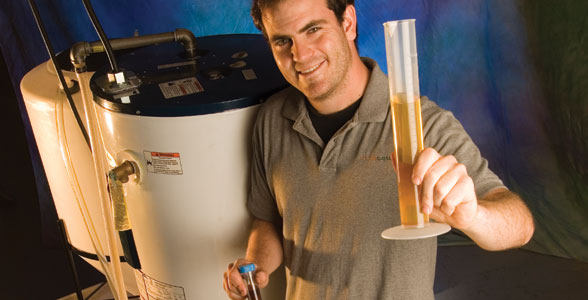When you hear University of Tennessee, Knoxville, student Scott Curran talk about “creating a model for campus sustainability,” it’s hard not to get caught up in his enthusiasm. Curran, a senior majoring in mechanical engineering, takes pride in the success of the efforts to not only use biodiesel fuel on the Knoxville campus but also create the fuel from campus resources.
Curran and other members of UT’s student chapter of the Society for Automotive Engineers began their work in spring 2004, during UT’s Environmental Semester. The group received a $10,000 grant to purchase the equipment and supplies to build a facility to produce home-brewed biodiesel right on campus.
Their idea, however, had a unique circular aspect that would make it more than just a student project. The group proposed to take waste cooking oil generated by UT Dining Services at locations all over campus and use it to make the biodiesel. Then to complete the cycle, they proposed using the fuel in university vehicles that already ran on biodiesel. “I think it’s the completely campus-contained model that catches people’s attention,” Curran says. “We’ve got the ingredients, we’ve got the tools to convert them to fuel, and we have a place to actually put it to use.”
It was from that simple progression that UT biodiesel was born.
From French Fries to Fuel
Just one look at the contents of a deep fryer tells you this isn’t something you should pour in your gas tank. Curran and his colleagues, though, see the makings of clean-burning fuel.
The process used to make the biodiesel is something like the way generations of people made lye soap in their own homes. In fact, if the reaction to convert the used cooking oil to fuel doesn’t go just right, the result is a rather large, foul-smelling soapy mess. “When they were first starting out, the students made a lot more soap than they did biodiesel,” says their faculty advisor, Dr. Butch Irick, a professor in the College of Engineering.
The process begins when Valley Proteins, the company that disposes of UT’s waste cooking oil, donates the oil to the student project. Curran and his colleagues collect the oil from UT campus dining spots and test it for purity, because some of it is just too dirty to be converted into usable fuel. When enough used oil makes the cut, the students can start the process of converting it into biodiesel fuel.
Their pilot plant is based on an open-source model called Appleseed, developed and refined by sustainable-technology enthusiasts. The most striking feature of the plant is a water heater like the one found in almost any modern home. The water heater is ideal because specific temperatures have to be reached and maintained during the fuel-making process, and the water heater provides a sturdy heat-tough tank combined with a heater and a thermostat.
First, the oil is filtered to remove any particles left over from cooking. Then it’s mixed with methanol and lye, and the mixture is heated. The resulting chemical reaction causes the oil to split into two parts, glycerin (glycerol) and methyl esters. The methyl esters are actually unrefined biodiesel fuel, but by engineering standards, before the output can be called biodiesel, it has to be “washed” in water to draw off the remaining alcohols and lye. As the fuel is washed, it becomes purer, and once purity standards are met, it officially becomes biodiesel.
Fill ‘Er Up
The lineup of UT vehicles that run on diesel fuel is an impressive sight. There are buses, backhoes, front-end loaders, and heavy-duty pickups–all of which can use biodiesel. Almost any diesel engine can use a biofuel called “B20”–B for biodiesel and 20 for the percentage of biodiesel in the mix, 20 percent. The other 80 percent of the mix is standard diesel.
Curran and his colleagues are able to produce 40 gallons of B100 (100-percent biodiesel) with every 2-week esterification and washing cycle. Since each gallon of B100 can be mixed with 4 gallons of standard diesel fuel to make 5 gallons of B20, 40 gallons of B100 yields 200 gallons of B20 biodiesel. And 200 gallons of B20 every 2 weeks meets or exceeds the fuel needs of UTK’s campus vehicles, so the biodiesel plant can enable the use of biofuel mix in all of the vehicles.
“The numbers don’t seem huge, but this makes a real impact on the university,” said Sarah Surak, public relations director for UT Facilities Services. “The program satisfies our biodiesel needs and then some.”
At a news conference to announce the program last September, UT Knoxville Chancellor Loren Crabtree and Curran performed a ceremonial first fueling of one of the UT buses with the first batch of biodiesel from the student plant. “This project reflects the ingenuity and commitment of our students and the willingness of the administration to further environmental efforts here on campus,” Crabtree said.
But beyond saving money on fuel and recycling waste oil, the biodiesel project helps cut down on the amount of greenhouse gases in the exhaust from UT vehicles. Curran says that using biodiesel cuts almost every kind of harmful emission.
“What I’d like to see is for more students to take the project over and learn from it. It’s not just an experiment,” he says. It’s about UTK’s citizens finding a way to use campus resources–a way that’s good for the environment and can even be a model for other universities.



